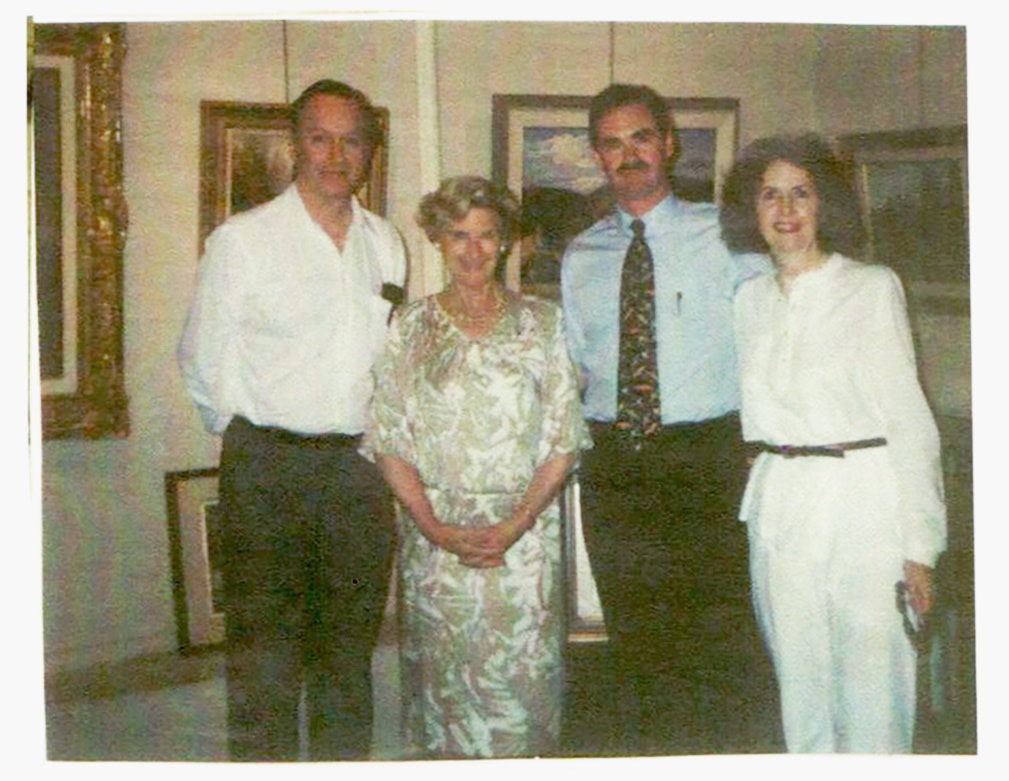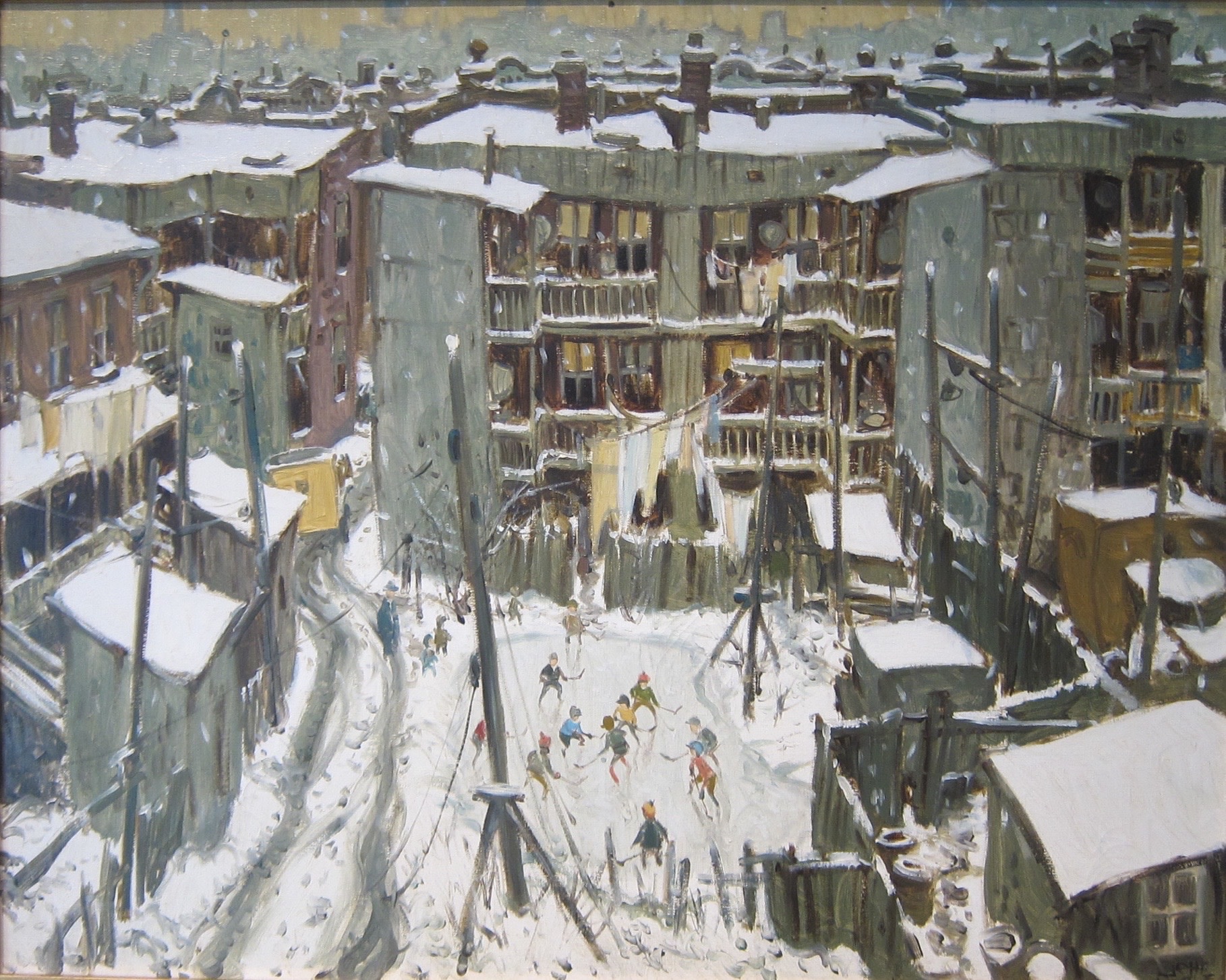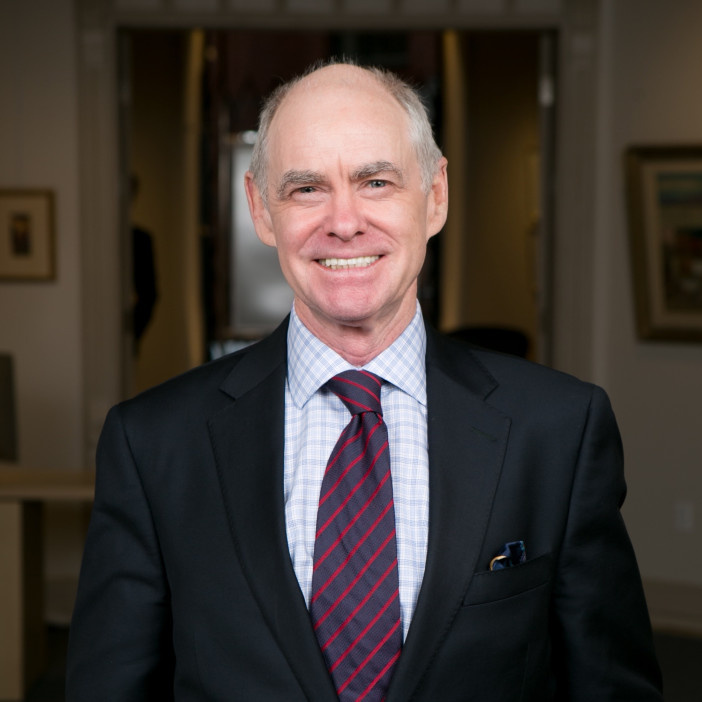A Tribute to John Little, City Life from 1951
John Little is the foremost figurative Canadian urban artist of the post-World War II generation. He is a visionary, an honest, humble and authentic artist.
Although John Little’s painting places are limited, primarily to the neighbourhood streets of urban Montreal and Quebec City, they serve as an allegory for the countless downtown streets and neighbourhoods throughout North America and beyond threatened, eviscerated and even totally demolished by the then popular government sponsored policies of urban renewal, otherwise called urban redevelopment. He is unique among artists of his generation, earnestly chronicling in an original and painterly style what the cities were losing, what they had already lost and what the citizens risked losing should the bulldozer approach continue. Only come the mid 1970s did politicians and urban planners begin to identify their errors.
From the beginning of his career, Little was “ [ ...] preoccupied by that stuff that is really good to paint. Then they tear it up and ruin it,” he said to me. He was not politicized. His interest was not that of an an activist. Little wanted to paint the story of what he thought rather precious composition, which the downtown offered. Drawing and photographing on the spot in neighbourhoods that stimulated his artistic sensibilities, Griffintown, Pointe St. Charles, St. Henri, The Plateau, and elsewhere in Montreal and neighbourhoods in Quebec City, afterwards painting in his studio his interpretation of what he had captured. Then, as he was to imply publicly in 1961 and in conversation with me in ‘94, the bulldozer would arrive and “tear it up and ruin it”. His “ stuff that is really good to paint” was incidentally the social and architectural heritage that was under assault by the golden era of construction of urban renewal.
Little often used as his input the same drawings and photographs, re-composing after the streets had been disfigured by demolition or unsightly reconstruction. As his style evolved, Little’s interests in recreating an earlier scene were twofold. The first was to attempt to tell his story better than he had previously, an improved record of our heritage for the 'family album'. The second was to resurrect parts of our heritage in paint sometimes to remind us of what we have to celebrate and at others what we have lost to the wrecker’s ball. His legacy merits his place among the finest artist chroniclers in paint, print, film and in photography. His chronicles provoke his viewers to think about and reconsider the value of what we are doing or what we have already done.
Unlike other artists who have been as taciturn as is Little about their artwork, Jean Paul Lemieux, Philip Surrey, Edward Hopper and Balthus as examples, Little has continually withheld reproduction rights of his paintings and rejected requests from authors to write about him. This has left his work unpublished and undefended. Because right of reproduction was withheld, art historians and curators have been unable to include images of Little’s paintings in their publications.
Although John Little has given us his written endorsement to pursue this tribute, not unexpectedly, he has elected not to participate beyond granting us this opportunity. We are grateful to John Little for permitting us to share his paintings and his own words with his audience. We can only hope that we have represented him and his career justly.

John Little, Gertrude Klinkhoff, Alan Klinkhoff, and Lorraine Little
He kindly sent along a lovely photo I do not recall having seen previously, one of John, Mom, me (with both a moustache and a full head of hair) and a smiling Lorraine Little. Because of his modesty and his desire for privacy, he has broken his silence three times in his entire career, twice in 1961 and then in 1994, and given us glimpses in words of his thoughts beyond the paintings themselves.
“‘If we knock down all our old buildings and neighbourhoods we’ll become 'a people without a past’. [This] is how a Montreal artist named John Little feels about the aging beauty of the streets and houses that are always the ones to be hit by the wrecker’s hammer first.’” This critical statement Little made publicly in Maclean's Magazine in 1961 at the height of a popular bulldozer policy approach to what was being touted as “urban renewal” and land redevelopment in urban areas. “My motto is new plumbing for old buildings [ ...] I don’t mean to preserve everything, but there is so much in this city worth preserving [...]” (Newlands)
To Peter Desbarats at The Montreal Gazette in January of 1961, ''All these blasted parking lots,'' he said. ''They make Montreal look like a beautiful woman with half her teeth missing." (Desbarats)
For those who don’t follow these urban issues, or are too young to remember, 1961 is the same year American author, journalist, and activist, Jane Jacobs, published her landmark book, The Death and Life of Great American Cities, in which she decried the then popular theories on urban planning. “New ideas must use old buildings,” she wrote. “Old ideas can sometimes use new buildings. New ideas must use old buildings.” It took more than fifteen years for officialdom to begin reviewing what they were doing and still more to admit their folly in the destruction and demolition and then look for other solutions. Artist John Little had been telling and preserving the story of selected neighbourhoods, often “unselfconscious” ones, drawing and then composing them on canvas from the early 1950s.

John Little, Faubourg à m’lasse, Dorion Street, 1965
Oil on canvas, 24 x 30 in
Private collection, Quebec
While Little’s paintings are often enjoyed for their painterly virtues, there is more, much more. A cursory glance at Little’s composition of backyard hockey at Faubourg à M’Lasse, Dorion Street, 1965, many would praise it from the perspective of the visual pleasure it exudes. What fun! However, the backstory is that the painting is of the precise neighbourhood demolished under the mandate of eminent domain resulting in the eviction of 5,000 citizens, and bulldozing of 12 grocery stores, 13 restaurants and about 20 factories. Consequently, the painting takes on an added dimension. This is an important distinction of his œuvre and one Little has (almost) never talked about beyond the canvas. Our benefit from Little’s work is the sense of the Faubourg à M’Lasse neighbourhood Little celebrates in three important paintings in our display. Thanks to Little, the neighbourhood and its fine heritage is now forever included in the “family album”.
Exceptionally, at the insistence of an official from Canadian Cultural Programmes in 1994, John Little agreed to speak about Montreal in art, that is painting, at the Montreal Museum of Fine Arts. John’s acceptance was contingent on me being his mouthpiece!
This was a huge privilege and responsibility. I had known John Little all my life; he is modest and self effacing, guiding himself by the concept that if one wants to be a bore, one should talk about oneself. Socially, he maintains his privacy, masks a certain temerity and is the paragon of humility preferring to engage friends and admirers with a wonderful sense of humour, stories of legendary baseball or hockey teams, games and players, boxers, wrestlers, jazz musicians and reminiscences of Montreal’s jazz clubs usually of the 1950s or early ‘60s era. I accepted the honour to speak for him on the condition that he would permit me to interview him and Lorraine, an inseparable team since their marriage in 1952, one morning a week over a few weeks.
The transcripts of our interviews, supported by the 1961 Maclean’s photo essay, plus notes he sometimes penned on the back of his paintings, along with the occasional letter exchanged with Little and our extensive experience with Little’s paintings reveal an artist whose stature to date is not fully appreciated.
The intention of this essay and tribute exhibition is to present Little in a manner that for reasons of privacy he has until now, consistently resisted and even prohibited. Revealing Little not only in his art but also in his own words illuminates a dimension many collectors and students of Canadian art, museum curators included, will not have previously appreciated. We anticipate that one or another of the national museums will soon undertake a study of post World War ll urban art in Canada. Insofar as his career spans 65 years, our exhibitions permits only a small selection of his oeuvre. However, with the first hand insight this presentation provides and the paintings we feature we hope to entice the interest of Canadian art scholars to pursue a much greater study of John Little than small commercial galleries are able. We predict that their conclusions will place Little at the forefront among Canadian artists of his generation.
Since it is primarily for the City of Montreal that Little has conserved heritage and maintained part of the city’s “family album”, it is fitting that we offer John Little’s record during Montreal’s 375th anniversary.
Due to the limitations of space in our galleries, only some of the paintings will be exhibited in both our Montreal and Toronto galleries while others will be on view only in one venue. However all the paintings in our presentation are available for viewing online at www.klinkhoff.ca.
Alan Klinkhoff Gallery is proud to present A Tribute to John Little, City Life from 1951.





Add a comment